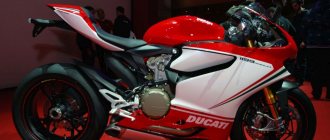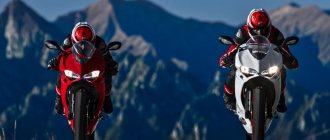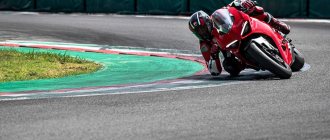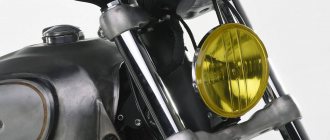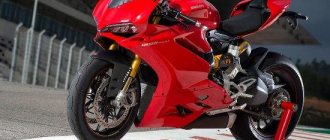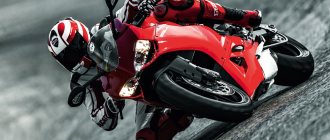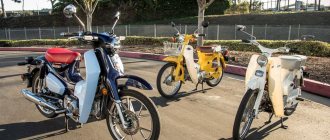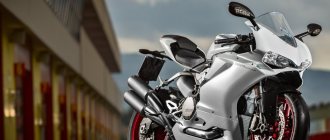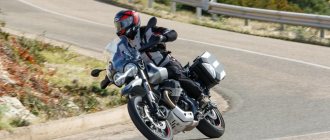Ducati Panigale V4 S 2020
I didn't like the first generation Ducati Panigale V4 S. Yes, the Panigale was a best-seller among sportbikes, and yes, every fourth sportbike sold in the world is a Ducati Panigale, but it didn’t suit me.
Yes, its engine is a real monster, but, alas, it is installed in a completely wooden chassis. Where other sportbikes trace the trajectory with the precision of a scalpel, the Ducati Panigale is more like a chain saw, tearing out chunks of the distance due to brutal power, rather than due to the precision and sharpness of steering. Yes, you can drive a lap quickly on it, but try driving it like that for 20 laps in a row...
A couple of people disagreed with me... but the stopwatch was on my side.
We compared the Panigale with the Aprilia RSV4 RF, and one of the testers managed to do a better lap on the Ducati than the RSV4, but the very next lap was a couple of tenths of a second longer. And even more important, he rode consistently with the same time on the Aprilia, but he was never able to repeat his time on the Ducati. For a company that makes some of the most precise frames and chassis in the world of motorsports, the last Panigale was in many ways a mistake.
And then I compared the Panigale V4 R, homologated for World Superbike, with the liter version of the Stradale V4. And although I was not able to drive the R for long enough, I clearly felt the difference in the chassis - in terms of agility, response and handling in general. Wouldn't it be great if they put an S engine in this chassis?
Ask and it will be given to you
It seems that not only buyers, but also riders and even motorcycle journalists agreed with my review (a pleasant feeling: you understand that it’s not you who is old, but a strange motorcycle). And Ducati heard us - releasing the new and improved Panigale V4 and V4 S. The task for the designers was set as follows: the new Panigale V4 should be easier to control, less demanding of the rider and faster. Sounds simple, right? And at first glance, it looks like they took a big engine and put it in an R frame. Yes, the engine, by the way, remained the same, but everything else became much more interesting. Let's move on to the details.
Ducati Panigale V4 S 2021
Ducati Panigale V4 S 2020
Aerodynamics
The hood of the R version is now used on other variants, reducing rider fatigue and making riding easier. In stock, the motorcycles are equipped with a 34 mm higher windshield, previously available as an option. The widest point of the front fairing (about 2cm behind the headlights) is now 15mm wider than before, and the side trim is 38mm wider than before. Together, this provides a higher and wider “screen” that shields the rider from oncoming wind and reduces head, shoulder and neck fatigue. Another advantage of using the R version hood was the removal of hot air from the motorcycle. Now the flow through the main radiator is increased by 6%, and the oil cooling radiator is ventilated 16% better.
But the most noticeable difference on the new 2020 Ducati Panigale V4 S is the wings from the R. Created in collaboration with Ducati Corse, the company's racing division, the wings create 37 kg of downforce at 300 km/h, which increases grip and reduces the likelihood of wheelies , and also prevents “yaw” of the front wheel at high speeds. Of course, achieving such speeds and fully experiencing the properties of wings is not possible for every rider and not on every track, but more on this a little later.
Frame
Adding definition and feedback to the chassis is a challenge that Ducati definitely failed with the original V4 frame, making it too stiff. The R frame, which is now available on other models, was developed for World Superbike and features vents to reduce weight. As a result, torsional rigidity was reduced by 30% and braking rigidity by 15%. The moderately flexible chassis of the 2021 Ducati Panigale V4 S provides much better sensitivity and feedback from the wheels, especially from the front.
Chassis
But just changing the frame is half the battle. Further - more: the new Ducati Panigale V4 S 2021 has had an updated chassis as a whole , which led to an increase in the center of mass by 5 mm. This was the result of raising the front end (or lowering the fork) by 4mm. The rear shock absorber itself is 2mm longer, and the suspension arms are 5mm shorter. Even more feedback is achieved thanks to softer springs with increased preload. Ducati has published graphs and tables explaining the physics behind the new variant, but to put it mildly, softer springs provide more suspension travel and more feedback between bike and rider, resulting in improved control at all lean angles, as well as improved bump smoothing and increased traction both entering and exiting corners, as softer springs reduce wheel hop.
Electronic assistants
Whether you like it or not, we live in a time when superbikes are no longer unthinkable without electronics. And not in order to go faster, but in order to make driving safer. Oldfags can be sarcastic about this as much as they want, but even the most seasoned pros sometimes make a mistake that leads to disaster, let alone less advanced racers. Riding a fast, powerful and extremely responsive motorcycle without safety features is a recipe for disaster. And for serious racers (no matter what level), the ability to feel the safety margin without taking a dangerous step beyond it is a great thing, because it allows you to repeat and improve your lap times without worrying too much about not screwing up. So the electronic content of the new Ducati Panigale V4 S, made completely in the spirit of the times, is excellent. And in many ways - thanks to the six-axis inertia measurement device, on the basis of which the Panigale V4 implements:
- Inclined ABS
- Ducati Slide Control (slide control - anti-slip system)
- Ducati Wheelie Control (wheelie control - a system that prevents the front wheel from coming off)
- Ducati Power Launch (power launch is a system that ensures engine operation at the start: opening the throttle, etc.)
- Engine Brake Control
- Ducati Electronic Suspension (electronic suspension - S model only)
The 2021 Panigale V4 S motorcycles also feature Ducati Traction Control and a bi-directional quickshifter in EVO2 version , meaning shifts are quicker above 10,000 rpm and the traction control is more precisely calibrated for faster, smoother performance. Essentially, calibrating the traction control means faster acceleration.
Fuel cards
Taking into account the task of making the Panigale V4 S more convenient and lighter, Ducati has modified the engine fuel maps. It sounds simple, but it really isn't. Just ask Carlo Ricci Maccarini, a former Ducati Corse engineer who moved from the racing team to the main business about a year ago. Thanks to his skills in tuning Ducati MotoGP and World Superbike, he and his team more accurately determined the traction gradient for each throttle position, taking into account different conditions (traction control settings, riding mode, etc.). The goal was to make the connection between the right hand and the rear wheel more linear, making it easier to stabilize the throttle, especially when losing traction.
Finally, the powerful thrust from the 1103cc Panigale V4 S requires some reining in - so the engine's torque is electronically limited in first and second gear, and slightly limited in third for a more controlled connection to the surface. All available V4 thrust is available from fourth gear. I think the companies producing tuning ECUs are already rubbing their hands in anticipation.
Ducati Panigale V4 S 2020
TEST DRIVE - First impressions: Ducati Panigale V4 - Sounds like a V-Twin, but much better!
Following the official presentation of the new colors of the official MotoGP project in Bologna, the entire Ducati factory team moved to Valencia to test the main new product of the sports motorcycle industry - the Panigale V4. Here are the first impressions from testing the revolutionary sportbike.
MOTOGONKI.RU, January 22, 2021 - Ducati officially closed the development program of the 1199 Panigale last year, releasing the “final version” of the bike with a 194 hp Testastretta Superquadro engine. In World Superbike, the last juice is squeezed out of the motorcycle, but the power ceiling from the 2-cylinder super-optimized unit has already been reached, and it is impossible to move on without compromising reliability. Reliability was the main reason Ducati riders retired in WSBK in 2016-17, when they tried to fight for the title with Kawasaki. The decision to abandon the V2 and switch to the V4 - at least in motorsport, which has been one of the main marketing components of the Bolognese factory for decades - did not come immediately.
Ducati Panigale V4 (2018)
And now, the Panigale V4S with the brand new 1103 cc V-Four. and a stated power of 212 hp. - already in motorcycle showrooms and on the race track! The fate of the Panigale V4 in World Superbike has not yet been determined: the engine capacity exceeds the permissible 1000 cc. for the SBK class, but it is quite possible to introduce amendments to the regulations. Therefore, this year the V4 will only appear in some national Open classes that are not subject to FIM requirements.
But different rules apply on the roads!
After testing in Valencia, at the Ricardo Tormo race track, where the MotoGP season ends, some of the journalists dubbed the Panigale V4S “Motorcycle of the Year” in advance. What is the reason for this explosion of emotions?
“Did the bike live up to our expectations?.. In a nutshell: it simply tore them apart!” - American CycleNews test driver Rennie Skisbrook said at the end of the test.
Ducati Panigale V4 (2018)
Ducati has managed to create a very smooth and controllable motor.
The Panigale V4 engine was inherited from the Ducati MotoGP racing department, from Desmosedici. Almost all the same technologies are used here, well, perhaps, without any pneumatics and seamless-trasmission. And everything here is concentrated on making the engine exceptionally tractable from the bottom up to the rev limit. The motorcycle is clearly controlled on the move from 1,500 rpm, and when it reaches 10,000 rpm, the response from the throttle simply breaks the roof.
Ducati Panigale V4 engine (2018) - originally from MotoGP
The engine sounds almost identical to the 1299 Panigale, thanks to its special firing order, with the same classic "metallic" notes in the voice. But it drives differently, of course.
Reverse rotation crankshaft of Ducati Panigale V4 (2018) - also from Desmosedici
Due to the fact that the crankshaft rotates in the opposite direction, a significant moment of inertia is created, directed forward and downward. This helps fight wheelie without resorting to electronically limiting the torque on the wheel - it is activated only in critical situations.
Next level electronics
If earlier the electronic packages used by Ducati were designed to protect the pilot from mistakes in handling the rather sharp and nervous Superquadro, then in the case of the V4, all electronics are an integral part of the system, helping to use the engine’s full potential.
Injector and throttle valve block
The torque is limited by closing the throttle valves, reducing the activity of the spark plugs and reducing the supply of the fuel mixture through the injectors, that is, softly and smoothly.
The V4S features a sophisticated, next-generation 6-axis inertial platform that monitors everything around it.
Ducati uses an intelligent traction control system (DTC EVO) in the V4S, linked to an anti-wheelie system (DWC EVO), an engine braking system (EBC EVO) and a unique Drift Brake Cornering Control (DSC). Quick-shifter comes standard with the V4S and is an integral part of the system.
Brains on wheels
The chassis of the motorcycle is very well thought out. The front part of the monocoque frame weighs only 4 kg. Through it, the engine is rigidly coupled to the front-end, and the rear-end is suspended from the rear of the engine, which is the Ducati tradition. But unlike previous models of top-end sports motorcycles, this time the plant moved away from using i.e. "budget" pendants.
Ducati Panigale V4 (2018): Showa Big Piston Fork (BPF) 43 mm
The production version of the Panigale V4 is equipped with a large 43 mm Showa Big Piston Fork (BPF) with a full range of adjustments. It's more expensive than Sachs, but much better in every way. But it still couldn’t be done without Sachs: the rear shock absorber and steering damper are from this manufacturer.
The V4S and Speciale versions use the active Ducati Electronic Suspension (DES EVO) based on the Öhlins NIX-30 fork and Öhlins TTX36 shock absorber. The second generation of Öhlins Smart EC 2.0 is faster and more precise, complemented by Ducati Corse's sport-specific Objective Based Tuning Interface (OBTi).
Smart pendants Öhlins NIX-30 with Öhlins Smart EC 2.0
DES redistributes the load between the front-end and rear-end after analyzing the road situation, so it is almost impossible to accidentally lift the bike into a wheelie or stoppie.
In general, at track days, an experienced pilot who has an understanding of the use of these features will have a real orgasm on the V4S.
Ducati Panigale V4S (2018): electronic wheelie and suspension control can be disabled, on V4 you just need to disable DWC
Braking at your fingertips
Ducati equips the Panigale V4S with new Brembo Stylema M50 monoblock calipers. Each caliper, cut with precision CNC machines from a single piece of aluminum that has been pre-tested by spectral analysis for flaws, weighs 70g less than similar models from last year.
The motorcycle is equipped from the factory with unique Pirelli Supercorse SP
As is tradition, the new super sports Ducati receives Pirelli's unique Supercorsa SP sports tires. The rubber used on the V4S was designed by Italian tire makers specifically for this motorcycle: the profile is higher than on the 1299 Panigale, which allows 100% of the chassis to be used. And the compound of these tires is designed for a load of 200 hp.
Pirelli Supercorsa SP special size for Ducati Panigale V4
Ducati remains Ducati - the bike requires effort
According to at least two American and one British test driver who took part in testing over the weekend, the Panigale V4 feels very close to the 1299 Panigale. The dimensions of the motorcycle allow pilots of different heights to feel comfortable in the saddle and actively move around the tank and in the saddle - back and forth, changing weight distribution in turns. The way the bike corners is also reminiscent of the good old Panigale - you need to put in a lot of effort to get it into corners, mainly the shoulders are tense. But the difference the V4 makes is that it is extremely stable on the arc.
Ducati Panigale V4 (2018)
The tall British test pilots could not ignore the fact that the 1103 cc superbike ended up being 2.5 kg lighter than the Panigale 959 Corse - only 195 kg!
Panigale V4 and V4S are not very different, but Speciale...
Equipped with an Akrapovič titanium exhaust system designed specifically for the V4 Speciale, the motorcycle with slightly modified firmware is capable of producing 226 hp. (again, according to the plant). All the electronics in the new V4 are tuned to give the driver the ability to tear apart opponents on the straight without the risk of losing control before entering a corner. Only a very experienced rider can unlock the potential of the Speciale, and it certainly won’t make much of a difference on the street.
Ducati intends to introduce the Panigale V4 R in Superbike spec in mid-2021, but the bike doesn't actually exist in the series right now. Single copies were received by two partner teams of the plant in the Italian racing series. The experience they gain there will form the basis of the superbike development plan for WSBK and other series.
The recommended price in the USA starts from $21,195, in Europe - from €22,590. The price difference between the Panigale V4 and V4S is almost $6500 or €5300, mainly due to the suspensions. The official price tag for the Ducati V4 in Russia has not yet been announced.
Photo: Ducati Media
Impressions from riding the Ducati Panigale V4 S 2021
The 5km track with 15 turns, two long straights and one VERY long straight is one of the few where a bike like this might actually need top gears. This is an excellent place for a press run for sports models, because it rains here at most 10 times a year.
And of course the event took place on one of these days! So I decided to postpone my own records until better times, and just for the pleasure of testing the new Ducati Panigale V4 S 2021, its Öhlins electronic suspension and Pirelli rain tires, which were promptly provided for the event. And at the same time check to what extent the task of “making driving easier” has been solved.
With rain tires (unfortunately not properly balanced by a local supplier) and the traction control set to 7 out of 8, I had no problem completing a lap in the rain. And the Panigale V4 S proved to be an experienced dance partner, seizing the initiative in time when necessary, and providing freedom of expression where it is permissible. The high degree of traction control intervention minimized wheel slip on wet pavement, and the gentle nature of the engine mode allowed me to quickly get used to it. As a result, my first laps on a new bike, a new track and in the rain were not at all what I expected... It was easy and pleasant, not at all what I expected from the Panigale V4, given my experience on the first generation S.
Ducati Panigale V4 S 2021 on the track
Having become a little more familiar with the track and appreciating the grip, I began to pay more attention to my own feelings from the motorcycle. And although it was impossible to say for sure due to the wet surface, my feeling is that the connection with the motorcycle, and through it with the track surface, has improved by an order of magnitude compared to its predecessor. And even the almost maximum level of traction control did not bother me. There was more than enough traction and acceleration for a good ride, and I didn’t want to lower the level of traction control at the risk of catching a highside. In addition, coming out of the turn on a long straight, the motorcycle carved two long waves of water along the track, slightly floating with the rear wheel. And at full throttle with a high level of traction control, I maintained control of the motorcycle quite confidently.
The driving mode was in the Road position. And in this mode, I set the traction mode to Track (this is the average value, the most aggressive is Racing). All three options provide full traction, but the Trek provides a more direct and linear response from the rear wheel to right-hand movements. This corrected some of the sluggishness of the response when exiting corners, which is especially useful before a long straight where you can put it in sixth and open up - the speedometer gets to 290 and turns off when it reaches 300 (thank the lawmen for that). And all this, let me remind you, in the rain!
Remember when I said that the Panigale V4 S fairing creates a “screen” that shields the rider from oncoming traffic? As soon as you lean out from behind this “force field”, the noise of the wind at a speed of under 300 (according to the speedometer) is simply deafening. Inside, it's calm and quiet, and even when I sat up under braking (made easy by the 330 discs and Brembo Stylema calipers), the windshield still diverted enough wind around and over the rider that it didn't feel like a sail. The wind protection here is better than on any other sportbike I've tested.
Ducati Panigale V4 S 2020
And he also has wings
Usually my opinion about them is that their effectiveness is difficult to assess, especially without comparing head-to-head with a similar, but “wingless” motorcycle. Ducati In the case of the Panigale V4 S, I seemed to be able to feel them: as I mentioned, the tires were not balanced enough for me, which caused unpleasant vibration at high speeds. Combined with the wet asphalt, I was almost expecting the Ducati to begin to yaw the front end and end up slipping.
But instead, the front tire holds its trajectory like a glove: despite the vibrations, the motorcycle goes exactly where I point it. I was not able to fully understand the contribution of the wings to this behavior, but I believe that they seriously helped. Of course, going three hundred to find out is a bad idea on a normal road, so Ducati will sell plugs for those who don't need fenders (or don't like the way they look).
High Speed Science
Algorithm for operation of Ducati driving modes
Driving Modes allow you to select three different pre-configured systems to tailor the performance of the new 2020 Panigale V4 to suit the driver's needs, track/route conditions and weather conditions. When switching driving modes engine performance , electronic control system parameters , and on motorcycles of the new S trim suspension settings also change . Riders can change settings to suit their personal riding style, while still retaining the option of restoring Ducati to factory settings.
Race driving mode
As the name suggests, Race riding mode has been designed for experienced motorcyclists who want to use the full potential of the new Panigale V4 2020 on well-surfaced race tracks . When selecting Race mode, 214 hp becomes available. With. , direct throttle control using the Ride by Wire system , as well as high suspension stiffness in the “S” trim , in order to enhance the overall performance of the motorcycle. In Race mode, all electronic control systems have a low level of intervention, which does not affect safety in any way. To improve braking performance, the ABS system operates only on the front wheel , but the cornering function remains active at all times.
Driving mode Sport
When selecting Sport becomes available . With. , direct sport throttle control via the Ride by Wire system , as well as sporty suspension stiffness in the new "S" trim . Electronic control system settings allow even inexperienced motorcyclists to enjoy riding this spectacular motorcycle. For example, in Sport mode, the brake slip function , which provides the ability to safely enter corners with controlled skidding. Rear wheel lift control is activated when braking, and the cornering ABS system is switched to maximum efficiency mode.
Street driving mode
Street driving mode is recommended when driving the Panigale V4 on roads . As in Sport mode, 214 hp is available in this driving mode. With. and proportional throttle control using the Ride by Wire system . On the new S trim motorcycles, this mode selects suspension settings that are best suited for rough roads. Electronic settings ensure optimal traction and stability for maximum safety.
Cons of the Ducati Panigale V4 S 2021
Yes, they are. Ducati has a strange habit of fitting its bikes with slippery footpegs, and the V4 S is no exception. Usually this is not a problem, but in the rain the boots slipped several times under heavy braking. I also lack some elbow room: they touch my knees when the fit is tight. One last thing is that the tank has a complex shape that means there aren't too many contact points for your knees to grip when braking or turning.
Another point that is not important to me personally, but those who like to service the equipment themselves may not like it: almost nothing on the Ducati Panigale V4 S 2020 is available for self-service. The nuts, screws, and latches are so well hidden that it will require remarkable skills to remove the plastic. I suppose even changing the oil yourself can be difficult.
Ducati Panigale V4 S 2020
